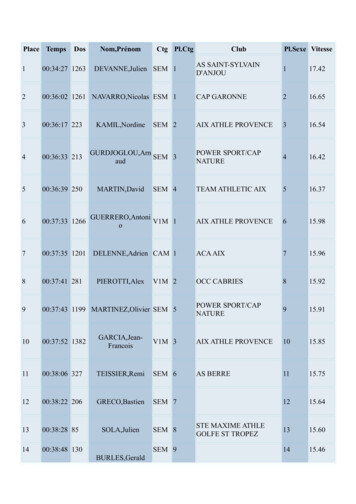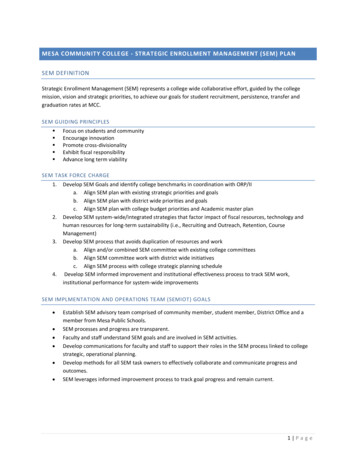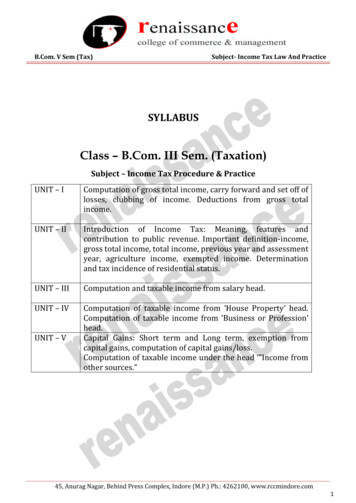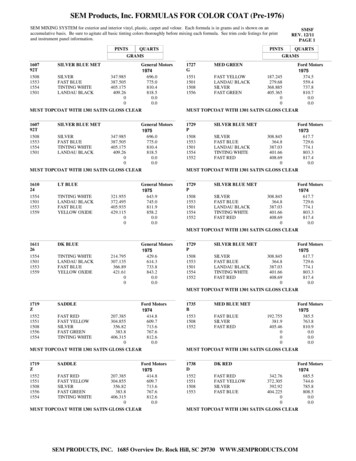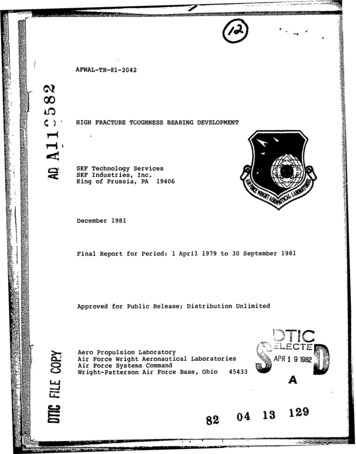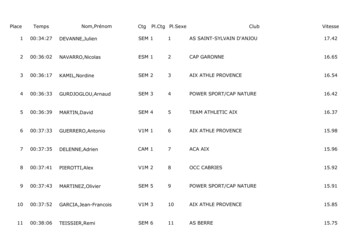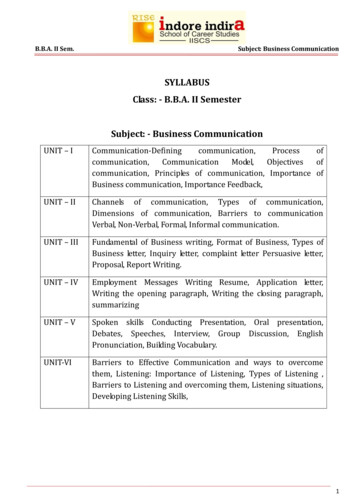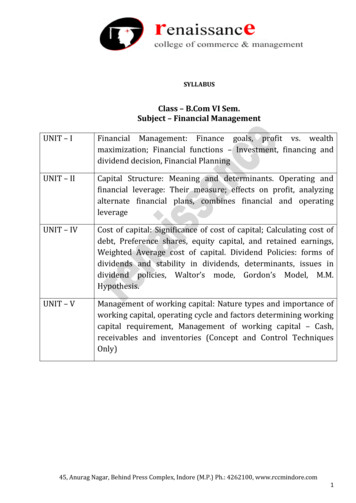
Transcription
SYLLABUSClass – B.Com VI Sem.Subject – Financial ManagementUNIT – IFinancial Management: Finance goals, profit vs. wealthmaximization; Financial functions – Investment, financing anddividend decision, Financial PlanningUNIT – IICapital Structure: Meaning and determinants. Operating andfinancial leverage: Their measure; effects on profit, analyzingalternate financial plans, combines financial and operatingleverageUNIT – IVCost of capital: Significance of cost of capital; Calculating cost ofdebt, Preference shares, equity capital, and retained earnings,Weighted Average cost of capital. Dividend Policies: forms ofdividends and stability in dividends, determinants, issues individend policies, Waltor’s mode, Gordon’s Model, M.M.Hypothesis.UNIT – VManagement of working capital: Nature types and importance ofworking capital, operating cycle and factors determining workingcapital requirement, Management of working capital – Cash,receivables and inventories (Concept and Control TechniquesOnly)45, Anurag Nagar, Behind Press Complex, Indore (M.P.) Ph.: 4262100, www.rccmindore.com1
Class – B.Com VI Sem.Unit – ISubject – Financial ManagementIntroductionIn our present day economy, Finance is defined at the provision of money at the time when it isrequired. Every enterprises, whether big medium or small, needs finance of carry on its operations andto achieve its targets, in fact finance is so indispensable today that it is rightly said to be the lifeblood ofan enterprise without code finance no enterprise can possibly accomplish its objectives.FinancePublic Financea.b.c.d.Government InstitutionsState GovernmentLocal-self govermnemtCentral governmentPrivate Financea. Personal financeb. Business Financec. Finance of Non-profitOrganizationHowever, there are three main approaches to finance1. The first approach views finance as to providing to funds needed by a business on most suitableterms, this approach confines finance to the raising of funds and to the study of financialinstitutions and instruments from where funds come to procured.2. The second approach relates finance to cash.3. The third approach views finance as being concerned with raising of funds and their effectiveutilization.Definition of Financial Management –“Financial Management is the operational activity of a business that is responsible for obtaining andeffectively utilizing the funds necessary for efficient operations.” – Prof. J.L. Marsie“Financial Management is an area of financial decision making, harmonizing individual motives andenterprise goals.” – Weston and BrighamFinance FunctionsExperts differ significantly as what are finance functions. Such difference in approach may be put undercategories:1. Traditional concept of Finance function2. Modern Concept of Finance functions45, Anurag Nagar, Behind Press Complex, Indore (M.P.) Ph.: 4262100, www.rccmindore.com2
Finance ProductionTraditional Approach(Corporate finance)Modern Approach(Finance Management)Procurement of fundsAcquisition of funds as wellas Utilisation of fundsIssues Involved Financial Institutions Financial Instrument Procedural Details Funds needed at episodiceventsIssues involved Total volumes of fundsneeded and acquisitionof asses Financing the fundsneeded Rate or growth1. Traditional concept of Finance functionAccording to traditional concept of finance function is related only to the arrangement of fundsfor the business. In other word, procuring necessary capital for the business is the function offinancial executive. Financial executive has to take decisions as to what are the sources ofcapital and how much funds should be raised, what is the proper time of acquiring such funds,on what conditions such funds should be raised etc.According to Soloman Ezro, The traditional approach thus focused more on sources of fundsand was too often largely concerned with specific procedural details.2. Modern Approach of Finance function.This approach attempts to answer the question like –a. What is the total volume of funds and enterprise should arrange?b. What specific assets should an enterprise acquire?c. How should the funds required be raised?d. What should be the composition of liabilities?e. How should profit be allocated?Capital Expenditure ncingDecisionsCurrent Assets Or workingCapital ManagementCash ReceivablesInventoryCost ofCapitalLong term sources (CapitalStructure Decisions)Short term sources (Workingcapital financing)Investment DecisionsInvestment decisions are concerned with selecting the right type of assets in which funds will beinvested by the firm. The assets which can e acquired fall into two groups: (i) Long-term assets (fixedassets), which would yield a return over a period of time to future, and (ii) short-term assets (also45, Anurag Nagar, Behind Press Complex, Indore (M.P.) Ph.: 4262100, www.rccmindore.com3
known as current assets), which are in normal course of business operations convertible into cashusually within a year. As such, investment decisions of the firm are of two types – long term investmentdecisions popularly known in the financial literature as ‘Capital budgeting’ and short term investmentdecisions i.e., financial decisions making with reference to current assets popularly designed as ‘currentAssets Management’.Financing DecisionsFinancial manager has to make a decision regarding raising of finances (funds) i.e. he has to decide thesource-mix or capital structure or leverage. The two important sources of financing are debt and equity.Debt is fixed interest source of financing and equity is variable dividend source of financing.A proper balance between debt and equity of ensure a tradeoff between risk and return is necessary.Financing decision involves capital structure decision along with its theory.Dividend DecisionsThe third major decision of financial management is the decision relating to declaration and payment ofdividend. Financial manager has to advise the top management (Board of directors) as what portion ofprofits should e distributed as dividend to the shareholders and what portion should be retained in thebusiness as well as part of investment decision.All these three financial decisions as finance function are inter-related because these have the sameobjective, i.e. maximization of wealth. As such, these should be jointly taken, so that financial decisionsmaking is optimal with reference to objectives of financial management.Nature and Characteristics of financial Management1. More analytical than descriptive2. A continuous & Dynamic process;3. An integral part of General Management4. strikes coordination in all functions5. centralized functions6. Scientific art.LIMITATIONS OF TRADITIONAL APPRAOCH1. One-sided approach2. Ignores the internal decision-making3. Applicable to company form of organization4. More emphasis on episodic events.5. Focus on the long term financing only6. Ignores the central issue of financial management.Modern ApproachThe central issues of Financial Management are ignored by the traditional approach.Experts like Walker, Hawrd and Lipton, soloman Ezra etc. have explained the finance function as afinancial decision-making.According to these experts, the meaning of finance function is confined not only to acquisition of fundsbut also to making effective use of such funds.Modern approach gives analytical frame work for financial problems. Under this Approach, three typesof decisions have to be taken- investment decisions, financing decisions and dividend-decisions.According to Soloman Ezra, "The newer broader approach aims at formulating rational policies, foroptimum use; procurement and allocation of funds."NATURE OF FINANCIAL MANAGEMENT1. More Analytical the descriptive2. A continuous & dynamic process.3. An integral part of General Management4. Strikes Coordination in all functions5. Centralized function.6. Scientific Art.45, Anurag Nagar, Behind Press Complex, Indore (M.P.) Ph.: 4262100, www.rccmindore.com4
SCOPE1. Estimating Financial Requirements- The first task is to estimate short term and longrequirements of his business. For this prepare a financial plan for present as well as future2. Deciding Capital Structure- The mixture of debt and 'equity maintaining by the firm.3. Selecting a source of finance- Various sources from which finance may be raised include:debentures, financial institutions, qpiri4Orcial banks, public deposits etc.4. Selecting a pattern of investments- It means the uses of funds.5. Proper Cash Management- Management of assets and liabilities. Cash Flow statement andLiquidity must be maintained in it.FUNCTIONS OF FINANCIAL MANAGEMENTThere are two types, of functions:A. Executive FunctionsB. Routine functionsA. Executive functions- Making reasonable forecast of Financial requirements and arranging thesources for the supply of funds, making effective and maximum use of funds provided by theinvestors etc are the objectives of financial management for which the following functions arecarried out:1. Financial Forecasting- It is the Primary function of financial management because it is thefoundation of financial planning. Forecasting about- new enterprises are made by promoters orinvestors while going concern financial requirements are being forecast by financial executives.Such forecasting needs the applications of various statistical mathematical and accountingtechniques.2. Financial planning- It is done under three distinct sub-activitiesa. Formulation of financial objectivesb. Framing the financial Policies College of Commerce & Managementc. Developing financial procedures.Both short term & long term plans are prepared with respect to each of above sub activities.3. Financial Decisions- It involves determination of financial sources, comparative study of theircost of capital, examining the impact on share holder’s equity etc.4. Financial Negotiations: It means contact all the possible suppliers of funds and to finalize thecontract through negotiations / talks. In this process statutory provision, rules and assumptionsare to be executed.5. Investment Decisions- Decisions about the investments' of funds Volume of fund/investmentsin fixed assets (long term investment) and volume of investments in current assets (short-terminvestments)6. Management of income- Correct distribution of income in correct proportion and following theappropriate dividend policy.7. Management of cash flows- Proper flow of cash is essential for every business Therefore adopt afair policy regarding the cash flow (both in flows & out flows) and also mange cash surplus!Deficiencies.8. Appraisal of Financial performing- It is necessary to evaluate & analyse the financialPerformance of the business concern in a definite interval and to communicate the results totop management.9. To make efforts for increasing the productivity of the capital- By the new opportunities ofinvestments.10. To Advise the top Management- Whenever top management has to advise the best solution bydiagnosis the problem, alternative solution to the problem. Selection of the best solutions.B. Routine Functions- These functions are being performed by lower-level employee on daily basis.All the top authorities take financial decisions with the help of these functions.1. Record keeping2. Preparation of various financial statements3. Arranging the cash balance as per requirements45, Anurag Nagar, Behind Press Complex, Indore (M.P.) Ph.: 4262100, www.rccmindore.com5
4. Managing the credit5. Safety of significant financial documents.OBJECTIVE OF FINANCIAL MANAGEMENTIt can be explained from two points of view- Macro level & Micro LevelMacro-level theory says the whole society is benefited. On the contrary, according to micro-leveltheory, the financial objective is determined as per the individual view point of a company, firm orenterprise.There are two mutually opposite thought regarding objective of financial management at Micro -level.A. Profit Maximization (P.M.O.) objectivesB. Wealth Maximization (W.M.O) objectivesPROFIT MAXIMIZATION OBJECTIVESThe objective of financial management of an enterprise is to maximize the profit. Financial Managershould select that alternative which may maximize the profit. In other words, all such actions whichincrease the profit should be undertaken and those which reduce the profit should be avoided.For maximizing the profit either production is to be maximized from limited resources or cost shouldbe minimized for a particular level of production volume.JUSTIFITION OF PMO1. Rationality2. Maximization of Social benefits3. Efficient Allocation and uses of resources4. Measurement Of success of decisions5. Source of incentives.LIMITATION OF PMOProfit maximization objective (PMO) is considered to be a very limited (narrow) objective, because ithas a no. of drawbacks.1. Ambiguity/ Loose Expression of the Term profit2. Profit Maximization objective ignores timings of benefit3. Fails to recognise the quality of benefits.Wealth Maximization Objectives (W.M.O)Wealth Maximization is the appropriate objective of an Enterprise Financial theory asserts that wealthMaximization is the single substitute for a stockholder’s utility.When the firm maximizes the stock holder's wealth, the individual stock holder can us wealth tomaximize his individual utility.MaximumUtilityMaximum StockMaximum CurrentRefersHolder’s wealthstock price peryshareStock Holder ′ 𝑠 𝑜𝑙𝑑𝑒𝑟 ′ 𝑠 𝑐𝑢𝑟𝑟𝑒𝑛𝑡 𝑁𝑢𝑚𝑏𝑒𝑟 𝑜𝑓 𝑠 𝑎𝑟𝑒 𝑜𝑤𝑛𝑒𝑑 𝑥 𝑐𝑢𝑟𝑟𝑒𝑛𝑡 𝑠𝑡𝑜𝑐𝑘 𝑝𝑟𝑖𝑐𝑒 𝑝𝑒𝑟 𝑠 𝑎𝑟𝑒RefersMerits of WMO1. Precise and unambiguous2. Considers the timing of benefits3. Takes case of quality of benefits45, Anurag Nagar, Behind Press Complex, Indore (M.P.) Ph.: 4262100, www.rccmindore.com6
FinancialIs concerned withFinancing DecisionInvestment DecisionDividend DecisionAnalysesRisk & ReturnRelationship (Trade)WealthBASIC FINANCIAL DECISIONS1. Investment Decisions- Investment decisions are concerned with selecting the right type of assets inwhich funds will be invested by the firm. There are two types of assets.a. Long term assets (Fixed assets)b. Short-term assets (Current assets)Long, term assets which would yield a return over a period of time in future. Long term investmentdecisions popularly known in financial literature as "Capital Budgeting".Capital Budgeting- The process of planning and managing a firm's long term investment.It is the planning process used to determine whether a firm's long term investments such as newmachinery, replacements machinery, new plants, new products and research development projects areworth pursuing. It is budget for major capital, or investment expenditure.Short term Assets which are in normal course of business operations convertible into cash usuallywithin a year.Short term investment decisions known as 'Current Assets Management' or 'Working capitalManagement'Working Capital Management- A management firms short terms assets and liabilitiesThese are decisions involving managing the relationship between a firms' short term-assets and itsshort-term liabilities.The goal of working capital management is to ensure that the firm is able to continue its operations andthat it has sufficient cash flow to satisfy both maturing short-term debt and upcoming operationalexpenses. It means the short term investment decision is the trade off between profitability andliquidity (risk)Financing; Decisions- Financing Decisions are concerned with the proper mix of debt & equity.Therefore, financing decisions are involves “capital structure decision.”Capital structure: - The mix of debt and equity maintained by the firm. The two important sources offinancing are debt and equity.Debt is fixed interest source: of financing is variable dividend source of financing. Decide theappropriate mix of debt and equity in such a way as to maximize the share holder% Wealth. A properbalance between debt and equity to ensure a tradeoff between risk & return is necessary.2. Dividend Decisions- The third major decision of financial Management is the decision relating todeclaration and Payment of dividend.Financial manager has to advice the top management (Board of directors) as what portion of profitsshould be distribute as dividend to the share holders and what portion should be retained in thebusiness for further investment.45, Anurag Nagar, Behind Press Complex, Indore (M.P.) Ph.: 4262100, www.rccmindore.com7
If adequate profitable within the enterprise; profits are to be retained because return toshareholders would be maximum and price of share would- also rise.If the enterprise does not have investment opportunities the profit should be distributed asdividends to shareholders.All these three financial decision as finance function are inter-related because these have the sameobjective, i.e., maximization of Wealth. (Share holder's wealth)Inter-Relation of Financial DecisionInvestmentFinancing DecisionDividend Decision45, Anurag Nagar, Behind Press Complex, Indore (M.P.) Ph.: 4262100, www.rccmindore.com8
UNIT – IILeverageIn finance, leverage (also known as gearing or levering) refers to the use of debit to supplementinvestment. Companies usually leverage to increase returns to stock, as this practice can maximizegains (and losses). Leverage is the degree to which an investor or business is utilizing borrowed money.Types of leverage –1. Opening leverage – The operating leverage is a measure of how revenue growth translatesinto growth in operating income. It is a measure of leverage and how risky (volatile) acompany’s operating income is. Operating leverage can also be measured in terms of change inoperating income for a given change in sales (revenue). Operating leverage reflects the extent towhich fixed assets and associated fixed costs are utilized in the business. Degree of operatingleverage (DOL) may be defined as the percentage to levering. DOL the Degree of operatingleverage (DOL) can be computed in a number of equivalent ways; one way it is defined as theratio of the percentage change in Operating Income for a given percentage change in Sales.2. Financial leverage – Financial leverage is the ability of the firm to use fixed financial charges to magnify theeffects of changes in EBIT on the firm’s earnings per share. In other words, financial leverage may be defined as the payments of fixed rate ofinterest for the use of fixed interest bearing securities to magnify the rate of return asequity shares. The use of the fixed-charges sources of funds, such as debt and preference capital alongwith the owner’s equity in the capital structure, is described as financial leverage orgearing or trading on equity.Degree of financial leverage – Degree of financial leverage (DFL) may be defined as the percentagechange in earnings (earnings per share) that occurs as a result of a percentage in earnings beforeinterest and taxes.3. Combined leverage – If both operating and financial leverage allow us to magnify our returns,and then we will get maximum leverage through their combined use in the form of combinedleverage. Degree of combined leverage (DTL) uses the entire income statement and shows theimpact of a change in sales or volume on bottom-line earnings per share.FORMAT OF LEVERAGEParticularSales (In Rs.)(-) Variable Cost Contribution(-) Fixed Cost EBIT(-) Interest EBT(-) Tax EAT(-) Preference Dividend Earning after Preference dividend(-) Equity Divided Net Profit (Retained Earning)Amount*************EBIT Earnings before Income & Tax – EBT Earnings Before Tax – EAT Earnings after TaxFormulae45, Anurag Nagar, Behind Press Complex, Indore (M.P.) Ph.: 4262100, www.rccmindore.com9
1. Operating Leverage 2. Financial leverage ��𝐵𝐼𝑇𝐸𝐵𝐼𝑇3. Combined leverage ��𝑒 𝑐 𝑎𝑛𝑔𝑒𝑠 𝑖𝑛 𝐸𝑃𝑠𝑃𝑒𝑟𝑐𝑒𝑛𝑡 𝑎𝑔𝑒 𝑐 𝑎𝑛𝑔𝑒 𝑖𝑛 𝑠𝑎𝑙𝑒𝑠or OL x FL𝑁𝑒𝑡 𝑃𝑟𝑜𝑓𝑖𝑡 𝑜𝑟 𝑅𝐸𝑡𝑎𝑖𝑛𝑒𝑑 𝐸𝑎𝑟𝑛𝑖𝑛𝑔𝑠𝑁𝑜 .𝑜𝑓 𝐸𝑞𝑢𝑖𝑡𝑦 𝑠 𝑎𝑟𝑒𝑠 3.P/V ratio 4.ROI 𝑃𝑒𝑟𝑐𝑒𝑛𝑡𝑎𝑔𝑒 𝑐 𝑎𝑛𝑔𝑒 𝑖𝑛 𝑠𝑎𝑙𝑒 𝑠𝑃𝑒𝑟𝑐𝑒𝑛𝑡𝑎𝑔𝑒 𝑐 𝑎𝑛𝑔𝑒 𝑖𝑛 𝐸𝐵𝐼𝑇𝐸𝐵𝑇1. Earnings per share (EPS) 5. Assets turnover𝑃𝑒𝑟𝑐𝑒𝑛𝑡𝑎𝑔𝑒 𝑐 𝑎𝑛𝑔𝑒𝑠 𝑖𝑛 ��𝑒 𝑐 𝑎𝑛𝑔𝑒𝑠 𝑖𝑛 ��𝑜𝑛Other Formulae2. Break even Analysisor𝑓𝑖𝑥𝑒𝑑 𝐶𝑜𝑠𝑡 𝑥 𝑡𝑖𝑜𝑛x 100sales𝐸𝐵𝐼𝑇Capital Employedx 100𝑁𝑒𝑡 𝑆𝑎𝑙𝑒𝑠Total SalesSome major points taken into consideration1. Interest in chargeable on debts only2. Total assets Debts Assets Equity CapitalOperating and Financial LeverageLeverage refers to relationship between two interrelated variables. In financial analysis, leveragereflects the response of one financial variable over some other financial variable.Leverage are of three typesa. Operating leverageb. Financial leveragec. Combined leverageSales Revenue- Variable cost Contribution- Fixed Cost EBITOperating LeverageCombined Leverage- Interest PBT- TaxFinancial Leverage PATOperating leverage is the tendency of the operating profits to vary disproportionately with sales.𝐶% 𝑖𝑛 𝐸𝐵𝐼𝑇Operating leverage orEBIT% 𝑖𝑛 𝑠𝑎𝑙𝑒𝑠 /𝑐𝑜𝑛𝑡𝑟Financial leverage is related to the changes in operating profit available to equity shareholders onaccount of changes in EBIT45, Anurag Nagar, Behind Press Complex, Indore (M.P.) Ph.: 4262100, www.rccmindore.com10
FL 𝐸𝐵𝐼𝑇EBTor% 𝑖𝑛 𝐸𝐵𝑇% 𝑖𝑛 𝐸𝐵𝐼𝑇or𝐸𝐵𝐼𝑇PBT PD /(1 t)Combined leverage – clarifies the combined effect of OL & FL𝐶% 𝑖𝑛 𝐸𝐵𝐼𝑇 /𝐸𝑃𝑆CL OL x FL orEBIT% 𝑖𝑛 𝑠𝑎𝑙𝑒𝑠 /𝑐𝑜𝑛𝑡𝑟OL explains the business risk while Fl deals with the financial risk. The more is leverage the higher isthe risk associated.Other formulae –Assets turnover ratio Debt assets ratio 𝑠𝑎𝑙𝑒𝑠𝑇𝑜𝑡𝑎𝑙 𝐴𝑠𝑠𝑒𝑡𝑠𝐷𝑒𝑏𝑡 𝑥 100𝑇𝑜𝑡𝑎𝑙 𝐴𝑠𝑠𝑒𝑡𝑠Debt Equity Ratio 𝐷𝑒𝑏𝑡 𝑥 100𝑇𝑜𝑡𝑎𝑙 𝐸𝑞𝑢𝑖𝑡𝑦Financial LeverageFinancial leverage is synonym of trading n equityOf course, Financial leverage may e called as refind form of trading on equity financial leverage isrelated to the change in EBIT. A business concern may increase the profit to equally share holders byincreasing the EBIT.In other words we can say, “When the rate of return available to equally share holders in caused to riseby the use of best and performance share capital, it is termed as FL.Financial Leverage (FL) 𝐸𝐵𝐼𝑇𝐸𝐵𝑇EBT – It is equal to the amount left after deducting interest on.DFL % 𝑐 𝑎𝑛𝑔𝑒 𝑖𝑛 𝐸𝐵𝑇% 𝑐 𝑎𝑛𝑔𝑒 𝑖𝑛 𝐸𝐵𝐼𝑇Combined leverage – “Who have observed that operating leverage affects the business risk and it ismeasured in terms of changes in EBIT due to changes in sales. Similarly financial leverage affectsfinancial risk and is measured in terms of percentage change in EBT or EPS relative to percentagechange in EBIT. Since both the leverage are closely reputed in ascertaining the ability of the firms tocover fixed charges. The mixture of the two would give combined or total leverage.Formula –CL OL x FLORCL Degree of combined ���𝑇DCL DOL x DFLORDCL %𝑐 𝑎𝑛𝑔𝑒 𝑖𝑛 𝐸𝐵𝐼𝑇%𝑐 𝑎𝑛𝑔𝑒 𝑖𝑛 𝑠𝑎𝑙𝑒𝑠xORDCL %𝑐 𝑎𝑛𝑔𝑒 𝑖𝑛 𝐸𝐵𝑇%𝑐 𝑎𝑛𝑔𝑒 𝑖𝑛 𝐸𝐵𝐼𝑇%𝑐 𝑎𝑛𝑔𝑒 𝑖𝑛 𝐸𝐵𝑇 𝑜𝑟 𝐸𝑃𝑆%𝑐 𝑎𝑛𝑔𝑒 𝑖𝑛 𝑠𝑎𝑙𝑒𝑠45, Anurag Nagar, Behind Press Complex, Indore (M.P.) Ph.: 4262100, www.rccmindore.com11
UNIT – IVCOST OF CAPITALThe concept of Cost of Capital (and its fair estimation) is very important from several points of view:a. Capital Expenditure Decisions: - Cost of capital is basic input information in capitalexpenditure decisions. In the case of Discounted Cash Flows methods (N.P.V. & T.V.D.P.B.P. etc.),the cost of capital is used to discount the future cash inflows. In the case of I.R.R., theascertained I.R.R. is compared with the cost of capital. Even in the case of traditional methodlike Accounting Rate of Return, the Cost of Capital is used for comparing A.R.R. and deciding theprofitability of the project. The decision in respect of a capital expenditure would be irrationaland wrong, if the cost of capital is not correctly determined.b. Capital Structure Decisions: - The cost of capital also plays an important role is designing thebalanced and appropriate capital structure. Each source of capital involves different cost anddifferent risk. The objective should be to raise the capital from different sources in such a waythat it optimizes the risk and cost factors. For this purpose, the cost of each source of capitalshould carefully be considered and compared with the involved in it. This importance of cost ofcapital can also be viewed in the context of country's economy as well.Assumptions of the Cost of capitalThe cost of capital and its determination as discussed in this chapter are based on certain assumptions,which are:1. Business Risk is Unaffected. It has been assumed that business risk complexion of the concernwould remain the same by accepting a new investment proposal The term 'business risk' refersto the variability in annual earnings due to change in sales.2. Financial risk is also unaffected. It is also our assumption that financial risk complexion wouldalso remain unchanged. Financial risk refers to the risk on account of pattern of capitalstructure.The Cost of Capital discussed here does not consider the business risk and financial risk. It is somethinglike rate of return with zero-risk level.TYPES OF COST OF CAPITALA. Explicit Cost and Implicit CostIt can easily be ascertained that raising of capital from any sourcewould involve a series of cash flows-starting with cash inflows (proceeds from the issue ofsecurities) and followed by annual cash outflows in form of interest payments, repayment ofprincipal, dividends, etc the explicit cost of capital is the internal rate of return, which acompany pays for procuring the finances. It can easily be seen that explicit cost of capital will beonly in the case of interest bearing loan. If the loan is interest-free, its explicit cost will be zeropercent, as no cash outflows of interest are involved, of course, the principal will be returnedbut its discounting rate will be zero.The concept of opportunity cost gives rise to 'implicit tog'. . The implicit cost of capital arises,when a company considers alternative uses of capital. The rate of return, which can be earnedby investing the capital in alternative investment (popularly known as opportunity cost) by thecompany or shareholders is known as implicit cost.B. Historical Cost and Future Cost. Historical cost refers to the cost which has already beenincurred for financing a project. It is, thus, calculated on the basis of past data. Future cost refersto the expected cost funds to be raised for financing a project. Historical cost it significant to theextent that it helps in projecting the future cost and providing an appraisal of the pastperformance, when compared with standard cost or predetermined costs.C. Average Cost and Marginal Cost. Average cost of capital is the weighted average cost calculatedon the basis of cost of each source of capital structure. (Detailed procedure has been discussedlater on). Marginal cost of capital is also weighted average but it is weighted average cost of newcapital raised by the company. Marginal cost of capital is considered as more important forcapital budgeting purposes and financing decisions.D. Specific Cost and Composite Cost. Capital can be raised from various sources and each sourcemay have different cost. The cost of each source (i.e., specific source) is known as specific cost.45, Anurag Nagar, Behind Press Complex, Indore (M.P.) Ph.: 4262100, www.rccmindore.com12
CONTROVERSIAL VIEWS REGARDING THE COST OF CAPITALThe concept of cost of capital is very useful and has considerable practical uti1iYiri the theory of finance. But it is also subjected to a lot of dispute. One point of dispute is related to the fact whethermethod and level of financing affect the cost of capital or not There are two important approaches in;this regard:a. Traditional Approach. According to this approach, a company's cost of capital depends uponthe method and level of financing or its capital structure. It means that a company can changeits overall cost of capital by changing its capital structure, i.e. increasing or decreasing debtequity ratio. Since the cost debt is cheaper due to lower coupon rate and also tax saving(interest on debenture is allowed as expenses) as compared to equity shares, the traditionaltheorists argue that the overall cost, capital (i.e., weighted average cost) will decrease withevery increase in debt component in the total capital structure. However, debt component inthe total capital employed should be maintained at proper level because cp, of debt is a fixedburden on profit of the company. If the company has low profit, the increase in debt componentmight have adverse impact upon the company's risk. The shareholders may raise their expectedrate, of return due to increased risk in the business.b. Modigliani and Miller Approach (M.M. Approach). According to this approach, a change incapital structure i.e., debt-equity ratio) does not affect the cost of capital. In other words, themethod and level of financing will not affect the cost of capital; this will remain constant. TheCost of Capital, Corporation Finance and Theory of Investment' published in AmericanEconomic Review, 48 June 1958, Modigliani and Miller have observed:1. The total market value of the firm and its cost of capital are independent of its capitalstructure.2. The cut-off rate for investment purposes is completely independent of the way in whichinvestment is financed.MEASUREMENT OF COST OF CAPITAL1. Determination of Specific Costs. The first state in the measurement of cost capital is thecomputation of the cost of individual source of capital. These source are:a. Debt (borrowed) Capitalb. Preference Share capitalc. Equity share capitald. Retained earnings.a. Cost of Debt Capital. Such capital is generally obtained through the issue of debentures. Thesefloatation costs and modes of issue have important bearing upon the cost of debt capital.The cost of debt capital is very simple to calculate. The usual formula will be:1Kd 𝑆𝑉 x 100 (without tax factor)Here, Kd Cost of debt capitalI Interest payable.SV Capital received (proceeds from issue)According to nature, debentures (debt) may be (i) perpetual, and (ii) redeema
Definition of Financial Management – “Financial Management is the operational activity of a business that is responsible for obtaining and effectively utilizing the funds necessary for efficient operations.” – Prof. J.L. Marsie “Financial Management is an area of financial
